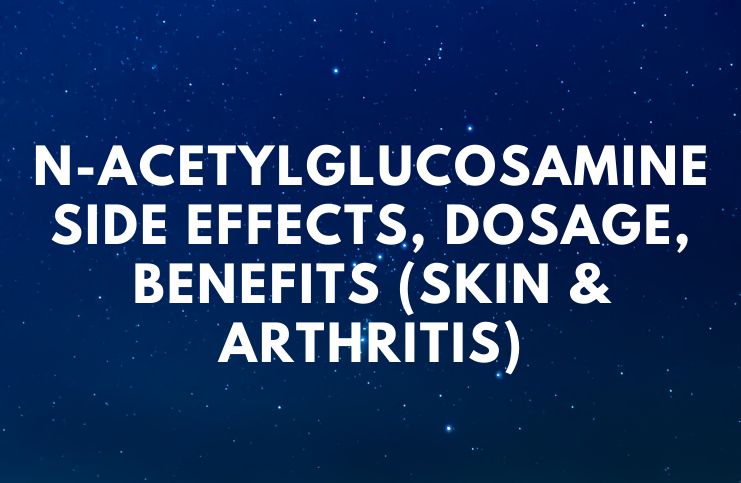N-acetylglucosamine (NAG) is a special sugar and a form of glucosamine, one of the main building blocks of joint tissue (areas where two or more bones meet) and other connective tissues.
NAG can come from the outer shells of shellfishes, as well it is synthesized in laboratories.
N-acetyl Glucosamine vs Glucosamine – Differences
Both are constituents of naturally occurring proteoglycans, glycoproteins, and glycosaminoglycans in human connective tissue and skin.
Glucosamine is naturally found in the joints in the human body but rarely found in natural food sources. On the other side, NAG is a chemical that comes from the outer shells of shellfish.
Moreover, according to a 2009 study, these two amino sugars have distinct molecular mechanisms arbitrating their differential biological activities in chondrocytes (the only cells found in healthy cartilage). Also, NAG has a larger, more complex molecule attached to it.
Benefits
Osteoarthritis
It might provide some pain relief for individuals with osteoarthritis of the hip, knee, or spine.
Osteoarthritis, the most frequent form of arthritis, is a joint disease and is the main cause of physical disability in seniors, that results from progressive destruction of articular cartilage. These changes typically develop slowly and get worse over time.
This is important since, by 2040, more than 78 million people in the United States aged 18 years or older are estimated to have doctor-diagnosed arthritis.
Inflammatory Bowel Disease
According to a 2000 study issued in Alimentary Pharmacology and Therapeutics, NAG shows promise in the treatment of inflammatory bowel disease (a group of intestinal disorders which includes colitis and Crohn’s disease) by supporting the human body’s creation of a healthy mucus layer in the gastrointestinal tract.
Moreover, it might support the growth of good gut bacteria, such as – Bifidobacterium bifidum.
Multiple Sclerosis
Multiple sclerosis is the most widespread disabling neurological disorder in young adults worldwide. For instance, it is estimated that approximately 2.5 million people around the world and about 400,000 people in the US have multiple sclerosis.
This supplement suppresses the growth and function of abnormal T-cells responsible for an autoimmune attack in diabetes type 1 and MS, according to a study done at the University of California Irvine Center for Immunology.
Acne
Acne is an inflammation of the skin which causes whiteheads, blackheads, and red spots typically called “zits” or “pimples.” The forehead is an area where pimples usually develop for a lot of people.
Supplementing with NAG may help lower the effects of acne caused by a food intolerance.
Bone Health
Osteoporosis is a bone condition that occurs when there is an imbalance between old bone resorption and new bone formation. Common signs and symptoms of osteoporosis include:
- frequent bone fractures;
- a stooped posture;
- loss of height over time;
- back pain, caused by a collapsed vertebra.
Many people with low bone density, bone pain, and a history of fractures can benefit from taking this supplement, which assists bone healing.
Collagen
Studies have shown that this supplement can increase the moisture content of the skin, collagen production (the most prevalent protein in the body), exfoliation, the elasticity of the skin, and the speed of wound healing.
Because it is a precursor to hyaluronic acid, its effects are effective in the hydrating process of the skin as well. It also has potent anti-inflammatory and antioxidant attributes that allow it to help prevent and heal sun damage. Additionally, it can help reduce signs of aging and prevent premature aging, like – wrinkles, particularly when mixed with niacinamide (also referred to as vitamin B3).
Dosage
The recommended dose is 3500 to 6000 mg per day. Because NAG affects the gastrointestinal tract, it is essential to increase the dose slowly. It usually comes in 500 or 750 mg pills.
Side Effects of N-Acetylglucosamine
Although rare, potential side effects of this supplement may include – nausea, indigestion, diarrhea, constipation, heartburn, headaches, and skin reactions.
It should not be mixed with anticoagulant drugs, like – warfarin, dabigatran, rivaroxaban, and apixaban. Also, it should be used cautiously by individuals who suffer from bleeding disorders, asthma, and kidney problems.
Although the production of NAG by chemical methods is estimated to be safe, the product is not considered a natural material because of its chemical modification and may contain trace amounts of di-acetylated and O-acetylated products.
Shellfish Allergy
If you are allergic to shellfish, it is recommended to avoid taking NAG as it can cause further allergic reactions, including:
- wheezing;
- vomiting;
- shortness of breath;
- dizziness or confusion;
- stomach cramps;
- blue coloring of the skin;
- indigestion;
- weak pulse;
- diarrhea;
- swelling of the tongue and/or lips;
- hives;
- trouble swallowing;
- a repetitive cough.
Increases Anxiety Levels
People with anxiety disorders typically have excessive and persistent fear and worry about everyday situations. According to some anecdotal evidence, some people experienced increased anxiety attacks.
Candida Virulence
Some studies reported that it helps change candida (an opportunistic fungus) from the yeast form to the invasive hyphal form, which is the form that causes intestinal permeability.
Not much research has been done on the side effects of this supplement during pregnancy, therefore, to avoid any health issues, it is recommended to avoid it while you are pregnant unless your healthcare professional has advised you to do so.
Images credit – Shutterstock
READ THIS NEXT: Dicalcium Phosphate (E341) – Side Effects
References https://www.ncbi.nlm.nih.gov/pubmed/11121904 https://www.ncbi.nlm.nih.gov/pubmed/15019194 https://www.ncbi.nlm.nih.gov/pmc/articles/PMC4997993/
